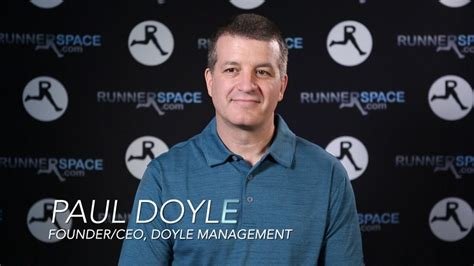This piece was done by Dave Hunter during the month of June 2021. He wrote this piece on Paul Doyle, an agent that he has come to admire. Paul Doyle is an example of the drive and desire needed to succeed as an athlete manager.
Paul Doyle: His Journey, His Vision
“Find a job you enjoy doing, and you will never have to work a day in your life.”
-Mark Twain-
Over the past 20+ years, Paul Doyle, fueled by his love for track & field, has built a successful sports management enterprise focusing on track & field athletes. Yet his early involvement with track & field was rather ordinary, providing no hint that he would go on to become both a highly successful track & field agent and a visionary driven to revitalize the sport. “I was a decathlete. I started off as a hurdler and then I started messing around with the pole vault,” explains Doyle in recalling his high school days. “And then, when I went to college the first day we had practice, I signed up on the sprinters and hurdlers list. And my coach came over and said, ‘No, no. You put your name on the wrong list. You’re a decathlete so you sign up on the multis and field events list.'” Doyle’s collegiate experience turned out to be nothing special. “I could have been really, really good,” explains Paul with care. “But, I suffered from a severe lack of talent.”
After earning his bachelor’s and master’s degrees in exercise physiology from UMass, Doyle, seeking a coaching position, began his climb up the ladder. “I was hired by Emory University to serve as head strength and conditioning coach for the whole university and as an assistant track coach. Emory was paying me $13,000 a year to do all that. Yet it just fueled my passion even more for the sport.”
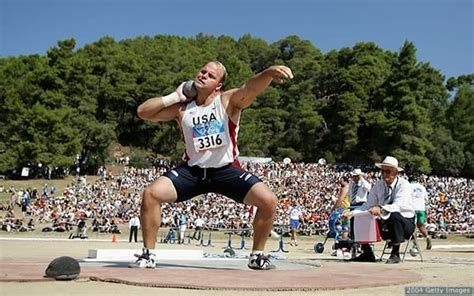 Adam Nelson, 2004 Olympics, photo by TeamUSA.org
Adam Nelson, 2004 Olympics, photo by TeamUSA.org
Before long Doyle joined forces with Coach Lauren Seagrave and they embarked on an independent coaching opportunity. “We were coaching this British hurdler named Peter Coghlan,” explains Doyle. “I think he had broken 14 seconds twice in his career. 13.86 was his PB. He wasn’t good enough for any of the mainstream agents to work with. So I said, ‘Heck, I’ll be your agent. It can’t be rocket science.’ So I basically started to become an agent to fill a need for Peter Coghlan. That first year he ended up running 13.30 and was the 3rd best hurdler in Europe that year. After that, he signed with a very prominent agent named Ray Flynn and I thought that I was done in the agent business – just one year.” But instead, Doyle soon learned he was just getting started.
“That next season – the 2000 season – I had a bunch of athletes who either were unhappy with their agents they had or didn’t have an agent, to begin with.” And Doyle suddenly saw an opportunity. “I thought, ‘You know, this might be a good way to travel with the athletes I’m coaching if I become an agent as well.’ Doyle explains. “The next thing I know I had athletes I wasn’t coaching asking me to be their agent. And I said, ‘Well, yes, I guess I could do that.’And it just exploded from there. You fast forward from there and in two years and all of a sudden I had 30 athletes.”
The first marquee athlete who signed with Paul was Adam Nelson, a 3-time Olympian and USA shot putter who captured Olympic medals at the 2000 and 2004 Games. “Adams was sort of the straw that broke the camel’s back,” remembers Doyle. “I think a lot of the athletes at the time – I was in my early 20’s – liked me and thought they might like to work with me. But I didn’t have that crowd of credibility. And once Adam Nelson came on board it was like ‘OK, Adam is with him. That means he’s legit.” laughs Paul. “When Adam came on board, the floodgates opened, and with all of the athletes coming on board the business certainly developed since then.”
But it was more than just the signing of an Olympic gold medalist that sparked Doyle’s business to take off. It was personal touch and attention to every little detail. “I don’t think you’re that far off. But you give me more credit than I deserve, to be honest,” offers Doyle. “I’ll admit that that’s our goal. We often don’t achieve it”. And with a wry smile, he adds, “Some of my high-maintenance athletes will call if a light bulb goes out in their apartment.” Commitment and innovation also play a role. “I’m not the most organized person in the world, I can promise you that,” admits Paul. “But to make up for that: we’ve done different things, unique things. We have our own online management portal for the athlete. And I have great people around me to make up for my commission fee. The biggest thing I feel that we do is we make a commitment to our athlete.
Doyle Management Group emphasizes loyalty with its clients and Paul cites an example of helping one of his athletes accused of engaging in performance-enhancing drug use. “He tested positive for a steroid that is used in cattle,” explains Doyle who assembled a defense team for his athlete. “He had eaten meat about 19 hours before his test,” states Doyle who notes that his athlete was ultimately exonerated. “I think a lot of other managers would have thrown in the towel and given up as I was told to do about 100 times and refused to do. That’s just one small example of our ‘ride or die with our athletes’ approach to ensure that they are taken care of.”
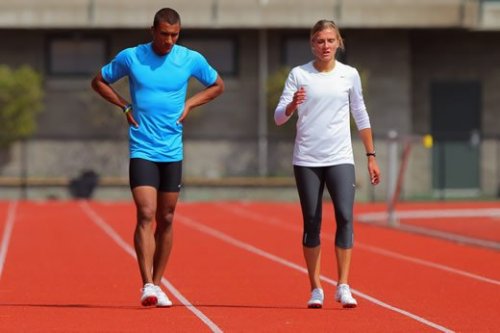 Ashton Eaton and Brianne Theisen-Eaton, photo by Doug Pensinger/ Getty Images for World Athletics, were represented by Paul Doyle
Ashton Eaton and Brianne Theisen-Eaton, photo by Doug Pensinger/ Getty Images for World Athletics, were represented by Paul Doyle
Athletes continued to knock on his door. But could Doyle’s venture be fiscally sustainable? “I remember sitting down with an Irish businessman,” Paul recalls. ‘And we were talking about the management business and he said to me, ‘How much money do you need to make?’. And I said, ‘I need $30,000 a year.” And he replied, ‘If you’re going to take that and you’re going to charge 15%, it means that your athletes have to earn $200,000 per year.’ And I remember thinking way back then, ‘Oh my God. How’s that possible?'” adds Doyle with a chuckle. “And now a good athlete is making $1.5 million a year on their big contract.” The young agent wondered if his business could flourish. “At the time I thought there was no way this could happen. I looked up to some of these other agents and I wondered ‘Is that even possible for me?’ After a pause, Doyle continues. “But I had that vision. The tag line for our company has always been, ‘A unique approach to athlete management.’ It’s not anything real specific, except nothing is off the table and we figure things out.”
With his business growing and solidifying, Doyle was able to expand his vision beyond just the athletes to the format of the sport itself. “Back in 1999 I had this first vision of what a track meet can be,” Doyle recalls. “I had this cool idea of taking fans out of the stands and letting them hold the starting blocks for the athletes, having ‘Battle of the Bands’ contests in between events, dancers- this whole idea of a track & field festival. It just remained in the back of my mind for the longest time.” And it still does. Paul has some distinct ideas which he believes will further lift the sport:
• On injection of entertainment: “You know, track & field has remained virtually the same for 100 years. We need to do something that appeals to the younger generation – even more so now as the fan base has changed. Attention spans have gotten shorter and everything has shifted such a huge amount. That is something we [ATL] try to do, but again we’re trying, we’re aspiring, but there’s a lot more we can try to do. Music is such a big part of entertainment these days. If you look at TikTok there are maybe 5 or 6 songs that are all over TikTok that people do dances to. Music is a driver of people’s interest in many ways. Infusing music into track & field is important. That’s why we like to have live bands if possible and certainly DJ’s and dancers for between events.”
• On the duration of meets. Track & Field is one of the few sports that is not a 2 1â„2 or 3-hour event – it goes all day! I think there has been a push among some coaches to change the format as well and start to shorten the college program. There is no reason why every single college meet has to have every single event: the hammer throw, the steeplechase, the 400m, the 100m, and on up. It’s impossible to have 32 different events at every single meet and keep it at 3 hours. You just can’t do it. There is this push among college coaches in some circles to shorten our program; let’s make our meet 3 1â„2 hours. If you shorten the program you make it more interesting.”
A moment that perhaps Paul will never forget was the beginning of this year’s first American Track League broadcast when, with Lewis Johnson and Sandi Morris behind the mics, reigning Olympic shot put champion Ryan Crouser opened the show with his first attempt – and indoor world record heave of 22.82m / 74’101â„2″. “It really was an unbelievable dam breaker for the meet. And there were some incredible things that happened after that as well,” proclaims Doyle. “But there’s not much better: first event; first throw; world indoor record.”
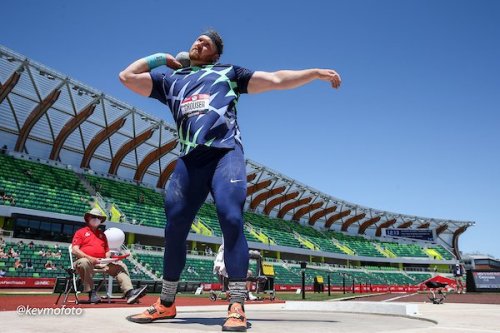 Ryan Crouser is a client of Paul Doyle, photo by Kevin Morris
Ryan Crouser is a client of Paul Doyle, photo by Kevin Morris
Paul knows the athletes have played an invaluable role in his quest to elevate the sport’s format.. “I’ve been incredibly humbled by the support the athletes have given to the League. And the athletes know that we don’t have the money to pay them what they deserve. That they still support us even despite those circumstances is really unbelievable. The athletes deserve way, way more – coming from virtually nothing and oftentimes paying their own way. For me, it is not the vision I have for the League.”
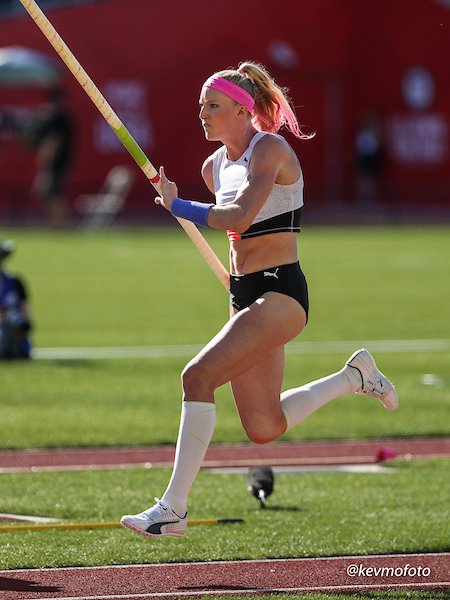 Sandi Morris is a client of Paul Doyle, photo by Kevin Morris
Sandi Morris is a client of Paul Doyle, photo by Kevin Morris
Paul Doyle takes a moment to step back and assess where he is on his mission. “We’re at baby steps right now. I’m excited about the future of the League. We’ve had a lot of momentum develop this year. And I think that is only going to carry over to future years. I am really hopeful that this thing can get to the level where I want it to be – which is well beyond where the Diamond League is.”
/ Dave Hunter /
Author
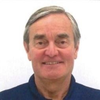
Dave Hunter is an award-winning journalist who is a U.S. Correspondent for Track & Field News. He also writes a weekly column and serves as Senior Writer for www.RunBlogRun.com, and covers championship track & field competition domestically and in such global capitals as Moscow, Birmingham, Zurich, Brussels, Beijing, Rio de Janeiro, Zagreb, Ostrava, and Doha. Hunter frequently serves as the arena or stadium announcer for championship track & field gatherings, including the Ivy League, the Big East, the Mid-American Conference, the NAIA, the Big Ten, and the Millrose Games. Hunter has undertaken foreign and domestic broadcast assignments. He ran his marathon P.R. 2:31:40 on the Boston Marathon course back in the Paleozoic Era. To find out more about Dave, visit his website: www.trackandfieldhunter.com He can be reached at: dave@trackandfieldhunter.com
View all posts

